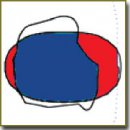
Calculation of Effective Freezing Time in Lung Cancer Cryosurgery Based on Godunov Simulation
There have been presented the results of lung cancer cryosurgery simulation using numerical solutions of enthalpy equation according to Godunov method. For the cryodestruction improvement purposes we successfully calculated the effective freezing time taking into account the evolution of an ice ball covering the tumor area. Geometrical transformation parameters of an ice ball have been measured by calculating the temperature distribution and the interface position in biological tissue. Mathematical cryosurgical procedures are described by heat transfer equations in solid and liquid phases. Numerical results for one-dimensional case were verified by comparing with exact solutions. In two-dimensional modeling an effective cryotherapy time, which corresponds to freezing time of all tumor parts, was calculated as the area of forming ice balls covering all tumor region. The findings enable to set the effective time of a cryosurgical procedure in lung cancer. The knowledge of temperature distribution and interface position in biological tissue offers an opportunity to a cryosurgeon to finish the procedure within a certain time period to minimize the healthy tissue damage and destroy tumor cells to the maximum. Simulation application enables to schedule cryotherapy in lung cancer more effectively and to a good quality.
- Spravochnik po onkologii [Handbook of oncology]. Pod. red. Moiseenko V.M. [Moiseenko V.M. (editor)]. Saint Petersburg; 2008.
- Kumar S., Katiyar V.K. Numerical study on phase change heat transfer during combined hyperthermia and cryosurgical treatment of lung cancer. Int J of Appl Math and Mech 2007, 3(3): 1–17.
- Wan R., Liu Z., Muldrew K., Rewcastle J. A finite element model for ice ball evolution in a multi-probe cryosurgery. Comput Methods Biomech Biomed Engin 2003; 6(3): 197–208, http://dx.doi.org/10.1080/1025584031000151185.
- Yang B., Wan R.G., Muldrew K.B., Donnelly B.J. A finite element model for cryosurgery with coupled phase change and thermal stress aspects. Finite Elem Anal Des 2008; 44(5): 288–297, http://dx.doi.org/10.1016/j.finel.2007.11.014.
- Rossi M.R., Tanaka D., Shimada K., Rabin Y. An efficient numerical technique for bioheat simulations and its application to computerized cryosurgery planning. Comput Methods Programs Biomed 2007; 85(1): 41–50, http://dx.doi.org/10.1016/j.cmpb.2006.09.014.
- Rossi M.R., Tanaka D., Shimada K., Rabin Y. Computerized planning of cryosurgery using bubble packing: an experimental validation on a phantom material. International Journal of Heat and Mass Transfer 2008; 51(23–24): 5671–5678, http://dx.doi.org/10.1016/j.ijheatmasstransfer.2008.04.045.
- Shi J., Chen Z., Shi M. Simulation of heat transfer of biological tissue during cryosurgery based on vascular trees. Applied Thermal Engineering 2009; 29(8–9): 1792–1798, http://dx.doi.org/10.1016/j.applthermaleng.2008.08.014.
- Zhao G., Zhang H.-F., Guo X.-J., Luo D.-W., Gao D.-Y. Effect of blood flow and metabolism on multidimensional heat transfer during cryosurgery. Med Eng Phys; 2007; 29(2): 205–215, http://dx.doi.org/10.1016/j.medengphy.2006.03.005.
- Shih T.-C., Yuan P., Lin W.-L., Kou H.-S. Analytical analysis of the Pennes bioheat transfer equation with sinusoidal heat flux condition on skin surface. Med Eng Phys 2007; 29(9): 946–953, http://dx.doi.org/10.1016/j.medengphy.2006.10.008.
- Chua K.J., Chou S.K., Ho J.C. An analytical study on the thermal effects of cryosurgery on selective cell destruction. J Biomech 2007; 40(1): 100–116, http://dx.doi.org/10.1016/j.jbiomech.2005.11.005.
- Deng Z.-S., Liu J. Analytical study on bioheat transfer problems with spatial or transient heating on skin surface or inside biological bodies. J Biomech Eng 2002; 124(6): 638–649, http://dx.doi.org/10.1115/1.1516810.
- Chua K.J., Chou S.K., Ho J.C. An analytical study on the thermal effects of cryosurgery on selective cell destruction. J Biomech 2007; 40(1): 100–116, http://dx.doi.org/10.1016/j.jbiomech.2005.11.005.
- Voller V.R., Shadabi L. Enthalpy methods for tracking a phase change boundary in two dimensions. International Communications in Heat and Mass Transfer 1984; 11(3): 239–249, http://dx.doi.org/10.1016/0735-1933(84)90040-x.










